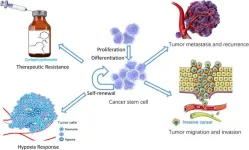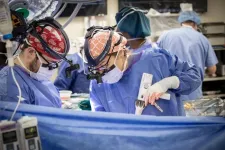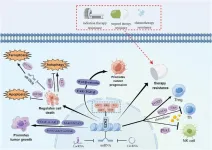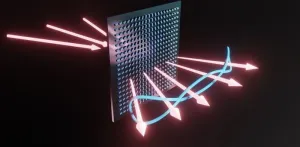(Press-News.org) Incidents of children in the U.S. being poisoned by the synthetic opioid fentanyl “increased and became more severe”, a new study reveals.
Launched today as Congress continues to review the HALT Fentanyl Act, the research follows an analysis of nonfatal fentanyl pediatric (aged 0-19) exposures reported to poison centers in 49 U.S. states from 2015 through to 2023.
In total, some 3,009 cases were detailed across the eight-year period.
In 2023 alone, 44.6% were life-threatening incidents in which there was extreme harm that could have resulted in death if not treated – an increase of these severe cases from 15.9% in 2015.
The majority (81.7%) of patients aged 0–12 were exposed unintentionally.
Most patients (65.7%) aged 13–19 were noted as having used fentanyl intentionally for nonmedical purposes.
Most incidents (1,771) were in youth aged 13–19 (58.9%), compared with 1,238 cases (41.1%) involving children aged 0-12. Males accounted for 58.5% (1,754) of all cases and females 41.5% (1,244).
The peer-reviewed findings are published in The American Journal of Drug And Alcohol Abuse, as the U.S. continues to battle a severe opioid crisis “driven by fentanyl use”. Fentanyl with co-use of psychostimulants has come to define the “fourth wave” of the opioid crisis.
Counterfeit pills containing fentanyl “flood the illicit market”. And in recent years, seven out of every ten counterfeit pills seized contained a potentially deadly amount of fentanyl.
Since 2021, there have been over 70,000 synthetic opioid-related deaths per year; although the latest, provisional data shows such deaths are decreasing.
It is understood that friends are a major source of prescription pills among adolescents and social media, too, is commonly used to purchase drugs from strangers. Various drugs not directly purchased from a pharmacy can be adulterated with fentanyl.
Driven by a “lack of focus on nonfatal overdose and how pediatric populations are being affected,” the expert team found exposures increased over the eight years. Among those aged 0-12 this was by 924.3%. For 13- to 19-year-olds there was a 1,506% increase.
Lead author Dr. Joseph Palamar, from the Department of Population Health, at NYU Grossman School of Medicine, in New York, says their results demonstrate the need for “increased prevention, treatment, and harm reduction”.
“We can’t forget that kids are also at risk during this opioid crisis,” explains Dr. Palamar, who is also Deputy Director of the National Drug Early Warning Network (NDEWS).
“Parents need to be aware that teens can purchase pills via apps that are sold as Adderall or Xanax but actually contain fentanyl.
“Parents and others, too, need to be careful to not leave fentanyl, whether licit or illicit, out in the open around unsupervised children.
“Even second-hand exposure to paraphernalia or baggies can contain small amounts of fentanyl can be lethal to youngsters.
“Children may touch or ingest such items out of curiosity, through a lack of a sense of danger, or even imitation of a parent who uses. Even used fentanyl patches can lead to accidental or intentional poisonings among pediatric populations.”
Co-author Dr. Joshua Black, Senior Scientist at Rocky Mountain Poison & Drug Safety, a Division of Denver Health and Hospital Authority, adds: “Parents and peers need to be able to promptly detect signs and symptoms of opioid overdose—including looking pale, slow or no breathing, coma, sometimes constricted pupils—and know when to seek help.
“We encourage people to contact a poison center if they suspect a poisoning (1-800-222-1222) or call 911 if someone collapses, has a seizure, has trouble breathing, or can’t be awakened following drug use.
“Having naloxone available can reverse the potential overdose from opioids. Bystanders are present in about 40% of illicit opioid-related deaths so it is essential for bystanders to be able to respond.”
Fellow co-author Dr. Linda Cottler, Director of NDEWS, from the Department of Epidemiology, College of Public Health and Health Professions, College of Medicine, University of Florida, further recommends for parents and health care providers to “be aware of the importance of receiving training about these drugs and what they do and what they look like, and how to caution teens about the dangers of friends and siblings sharing diverted drugs”.
Limitations of the research, includes that the data source used only captures a portion of fentanyl-related poisonings.
“There is a lack of systematic collection of data on nonfatal exposures and a major limitation is that most people who are exposed or overdose do not contact poison centers,” the authors report.
Research reported in this press release was supported by the National Institute on Drug Abuse of the National Institutes of Health under award numbers U01DA051126 and R01DA057289. The content is solely the responsibility of the authors and does not necessarily represent the official views of the National Institutes of Health.
END
Children poisoned by the synthetic opioid, fentanyl, has risen in the U.S. – eight years of national data shows
Life-threatening effects logged in more than 44% of incidents
2025-03-08
ELSE PRESS RELEASES FROM THIS DATE:
USC researchers observe mice may have a form of first aid
2025-03-08
Humans may not be the only ones who aid their friends when they’re hurt. Mice may do it, too, as shown by a new research study led by scientists at the Keck School of Medicine of USC published recently in Science.
Scientists have been trying to understand why social mammals appear to help injured members of their species. There are numerous factors that determine empathetic behavior and social bonding in mammals, said Li Zhang, the principal investigator of the study and professor of physiology and neuroscience ...
VUMC to develop AI technology for therapeutic antibody discovery
2025-03-07
An ambitious project led by Vanderbilt University Medical Center investigators aims to use artificial intelligence technologies to generate antibody therapies against any antigen target of interest.
VUMC has been awarded up to $30 million from the Advanced Research Projects Agency for Health (ARPA-H) to build a massive antibody-antigen atlas, develop AI-based algorithms to engineer antigen-specific antibodies, and apply the AI technology to identify and develop potential therapeutic antibodies.
ARPA-H is an ...
Unlocking the hidden proteome: The role of coding circular RNA in cancer
2025-03-07
A new review article highlights the transformative role of circular RNA (circRNA) in cancer, revealing its potential as both a key player in tumor biology and a promising avenue for future therapies. Once thought to be noncoding RNA, circRNA has now been shown to encode functional proteins, challenging conventional RNA biology and opening up novel therapeutic possibilities.
Unlike traditional messenger RNA, circRNAs form a continuous loop, lacking the typical 5' cap and 3' tail. This unique structure was originally believed to preclude them from protein translation. However, recent discoveries demonstrate that specific internal ribosome entry sites (IRES) and N6-methyladenosine ...
Advancing lung cancer treatment: Understanding the differences between LUAD and LUSC
2025-03-07
Lung cancer remains one of the leading causes of cancer-related mortality, with lung adenocarcinoma (LUAD) and lung squamous cell carcinoma (LUSC) representing the most prevalent subtypes of non-small cell lung cancer (NSCLC). Despite their classification under the same umbrella, these two forms of lung cancer exhibit distinct genetic landscapes, therapeutic targets, and treatment responses.
Recent advancements in next-generation gene sequencing have identified key driver genes that differentiate LUAD and LUSC, influencing their respective clinical management approaches. LUAD is frequently associated ...
Study reveals widening heart disease disparities in the US
2025-03-07
A study published March 6 in The Lancet Regional Health — Americas highlights a growing divide in cardiovascular health in the U.S., showing that wealth and education play a significant role in heart disease risk.
The research, led by Salma Abdalla, MBBS, DrPH, an assistant professor of public health at Washington University in St. Louis, reveals that the top 20% of high-income, college-educated Americans have far lower rates of cardiovascular disease than the rest of the population — disparities ...
The role of ubiquitination in cancer stem cell regulation
2025-03-07
This review highlights the critical role of ubiquitination in governing the functionality of cancer stem cells (CSCs), shedding light on potential therapeutic targets for combating tumor progression, recurrence, and drug resistance. Published in Genes & Diseases, this article explores the intricate mechanisms through which the ubiquitin (Ub) system regulates key pathways essential for CSC maintenance and survival.
Ubiquitination, a fundamental post-translational modification, plays a pivotal role in protein stability, cellular signaling, and gene expression, particularly in the context of CSCs. Dysregulation ...
New insights into LSD1: a key regulator in disease pathogenesis
2025-03-07
A new review highlights the pivotal role of LSD1 (lysine-specific demethylase 1) in regulating critical cellular processes and its implications for human diseases. This article sheds light on how post-translational modifications (PTMs) influence LSD1 activity, impacting its function in gene regulation and disease progression.
LSD1 is a histone demethylase that plays a significant role in chromatin remodeling and gene expression by modifying histone H3 lysine residues. It interacts with various protein complexes, allowing it to serve as both a transcriptional activator and repressor. The intricate modifications ...
Vanderbilt lung transplant establishes new record
2025-03-07
Surgeons and teams with Vanderbilt Lung Transplant performed 99 lung transplants in 2024, the most ever in one year. Two of the procedures involved combined organ transplants.
For the second calendar year in a row, Vanderbilt Lung Transplant has the busiest program in the Southeast and leads the nation in innovation in organ preservation and regeneration.
The Vanderbilt Transplant Center is now home to the nation’s eighth largest lung transplant program by volume, and is among the best in long-term outcomes, demonstrating the ...
Revolutionizing cancer treatment: targeting EZH2 for a new era of precision medicine
2025-03-07
The critical role of EZH2, an essential epigenetic regulator, in cancer progression and treatment is underscored in this new review article published in Genes & Diseases. The study highlights the transformative potential of EZH2 inhibition, paving the way for a new generation of targeted therapies aimed at disrupting tumor growth and overcoming treatment resistance.
EZH2, a core component of the Polycomb Repressive Complex 2 (PRC2), plays a fundamental role in silencing tumor suppressor genes through histone methylation. Its overexpression has been ...
Metasurface technology offers a compact way to generate multiphoton entanglement
2025-03-07
Quantum information processing is a field that relies on the entanglement of multiple photons to process vast amounts of information. However, creating multiphoton entanglement is a challenging task. Traditional methods either use quantum nonlinear optical processes, which are inefficient for large numbers of photons, or linear beam-splitting and quantum interference, which require complex setups prone to issues like loss and crosstalk.
A team of researchers from Peking University, Southern University of Science and Technology, and the University of Science and Technology of China recently made ...
LAST 30 PRESS RELEASES:
First Editorial of 2026: Resisting AI slop
Joint ground- and space-based observations reveal Saturn-mass rogue planet
Inheritable genetic variant offers protection against blood cancer risk and progression
Pigs settled Pacific islands alongside early human voyagers
A Coral reef’s daily pulse reshapes microbes in surrounding waters
EAST Tokamak experiments exceed plasma density limit, offering new approach to fusion ignition
Groundbreaking discovery reveals Africa’s oldest cremation pyre and complex ritual practices
First breathing ‘lung-on-chip’ developed using genetically identical cells
How people moved pigs across the Pacific
Interaction of climate change and human activity and its impact on plant diversity in Qinghai-Tibet plateau
From addressing uncertainty to national strategy: an interpretation of Professor Lim Siong Guan’s views
Clinical trials on AI language model use in digestive healthcare
Scientists improve robotic visual–inertial trajectory localization accuracy using cross-modal interaction and selection techniques
Correlation between cancer cachexia and immune-related adverse events in HCC
Human adipose tissue: a new source for functional organoids
Metro lines double as freight highways during off-peak hours, Beijing study shows
Biomedical functions and applications of nanomaterials in tumor diagnosis and treatment: perspectives from ophthalmic oncology
3D imaging unveils how passivation improves perovskite solar cell performance
Enriching framework Al sites in 8-membered rings of Cu-SSZ-39 zeolite to enhance low-temperature ammonia selective catalytic reduction performance
AI-powered RNA drug development: a new frontier in therapeutics
Decoupling the HOR enhancement on PtRu: Dynamically matching interfacial water to reaction coordinates
Sulfur isn’t poisonous when it synergistically acts with phosphine in olefins hydroformylation
URI researchers uncover molecular mechanisms behind speciation in corals
Chitin based carbon aerogel offers a cleaner way to store thermal energy
Tracing hidden sources of nitrate pollution in rapidly changing rural urban landscapes
Viruses on plastic pollution may quietly accelerate the spread of antibiotic resistance
Three UH Rainbow Babies & Children’s faculty elected to prestigious American Pediatric Society
Tunnel resilience models unveiled to aid post-earthquake recovery
Satellite communication systems: the future of 5G/6G connectivity
Space computing power networks: a new frontier for satellite technologies
[Press-News.org] Children poisoned by the synthetic opioid, fentanyl, has risen in the U.S. – eight years of national data showsLife-threatening effects logged in more than 44% of incidents







